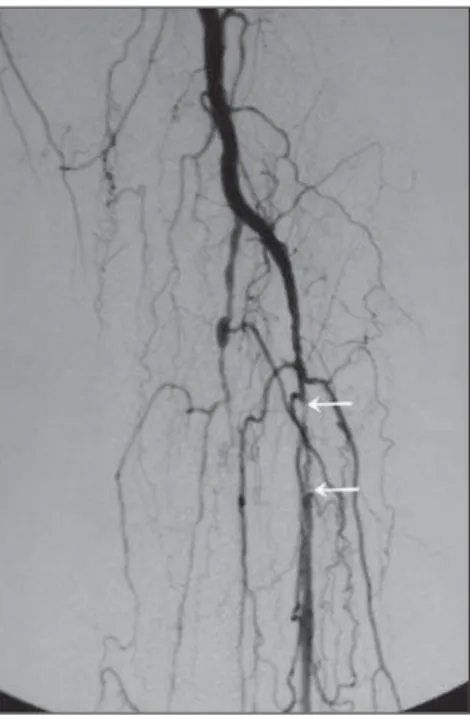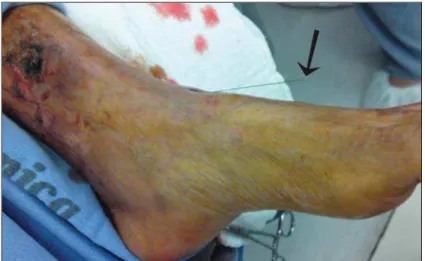302
Farret Neto A et al. Anterior tibial artery recanalization
Radiol Bras. 2012 Set/Out;45(5):302–304
Anterior tibial artery recanalization through dorsalis pedis
artery: a case report
*
Recanalização da artéria tibial anterior via artéria pediosa: relato de caso
Abdo Farret Neto1, Eduardo Dantas Baptista de Faria2, Ernesto Pantaleo3, Marcelo José
Carlos Alencar4, George Anderson da Penha Andrade4, Célia Maria Guedes de Lima5
The authors report the case of mixed approach for endovascular treatment of occlusive disease of the anterior tibial artery by retrograde pedal artery access where the traditional antegrade approach failed to overcome a segmental occlusion. The technique seems to offer an option for endovascular procedures aimed at treating occlusion of the anterior tibial artery in cases where the conventional antegrade approach demonstrates to be inappropriate.
Keywords: Angioplasty; Arterial occlusive disease; Percutaneous transluminal angioplasty; Tibial arteries; Endovascular procedures.
Os autores relatam um caso de abordagem mista para o tratamento endovascular de doença oclusiva da artéria tibial anterior por acesso pedioso retrógrado, no qual a abordagem tradicional anterógrada foi inadequada em vencer uma oclusão. A técnica parece oferecer uma opção para procedimentos endovasculares, que objetivam o tratamento de lesões da artéria tibial anterior em que a via anterógrada convencional mostre-se inadequada.
Unitermos: Angioplastia; Arteriopatias oclusivas; Angioplastia transluminal percutânea; Artérias tibiais; Procedimen-tos endovasculares.
Abstract
Resumo
* Study developed at Hospital Universitário Onofre Lopes, Natal, RN, Brazil.
1. Full Member of Colégio Brasileiro de Cirurgiões (CBC) and Sociedade Brasileira de Angiologia e Cirurgia Vascular (SBACV), Professor, Faculdade de Medicina da Universidade Federal do Rio Grande do Norte (UFRN), Angioradiologist and Vascular Surgeon, Hospital Universitário Onofre Lopes, Natal, RN, Brazil.
2. Professor, Faculdade de Medicina da Universidade Federal do Rio Grande do Norte (UFRN), Angiologist and Vascular Sur-geon, Hospital Universitário Onofre Lopes, Natal, RN, Brazil.
3. Angiologist, Vascular Surgeon, Vascular Sonographer and Trainee at the Unit of Hemodynamics – Hospital Universitário Onofre Lopes, Natal, RN, Brazil.
4. Graduate Students (6th year), Faculdade de Medicina da Universidade Federal do Rio Grande do Norte (UFRN), Trainees at the Unit of Vascular Surgery and Angioradiology – Hospital Universitário Onofre Lopes, Natal, RN, Brazil.
5. Master of Surgical Nursing, Nurse at Hospital Universitário Onofre Lopes, Natal, RN, Brazil.
Mailing Address: Dr. Abdo Farret Neto. Rua Doutor Múcio V. Ribeiro Dantas, 500, casa E/27, Ponta Negra. Natal, RN, Bra-zil, 59092-580. E-mail: abdofarret@gmail.com
Received April 3, 2012. Accepted after revision July 2, 2012.
Farret Neto A, Faria EDB, Pantaleo E, Alencar MJC, Andrade GAP, Lima CMG. Anterior tibial artery recanalization through dorsalis pedis artery: a case report. Radiol Bras. 2012 Set/Out;45(5):302–304.
0100-3984 © Colégio Brasileiro de Radiologia e Diagnóstico por Imagem CASE REPORT
Treatment with acetylsalicylic acid 100 mg/day + clopidogrel 75 mg/day was ini-tiated and anterior tibial artery recanaliza-tion by means of homolateral antegrade vessels, in most cases, allows the
reestab-lishment of the distal blood flow to the foot by means of angioplasty of at least one of such vessels(1,3). However, a recent study
has reported the failure in approximately 20% of most complex cases where the antegrade approach was utilized for revas-cularization(4).
Thus, in the setting of failure by the antegrade approach in overcoming the le-sion, angioplasty by retrograde approach can be utilized(5).
CASE REPORT
A female, 79 year-old diabetic patient with hypertension and coronary artery dis-ease. The patient presented with ischemic ulcers in her left leg, with slow course in spite of the instituted clinical treatment. The patient had normal popliteal and femo-ral pulses and absence of pulses in the left foot. The ankle-brachial index (ABI) at the dorsalis pedis artery was 0.58.
Angiography demonstrated segmental occlusion in the proximal third of the an-terior tibial artery and occlusion of the fibu-lar and posterior tibial arteries (Figure 1). INTRODUCTION
Diabetic arteriopathy is one of the main disorders referred to centers for treatment of peripheral ischemias. Revascularization of tibial arteries is frequently required for such treatment(1–3).
The development of new dedicated techniques and materials compatible with the anatomical and stenotic characteristics of affected vessels, particularly the tibial
303
Farret Neto A et al. Anterior tibial artery recanalization
Radiol Bras. 2012 Set/Out;45(5):302–304
approach was indicated. After the position-ing of a 5F long introducer sheath (Angio-Line®; Biometrix, Jerusalem, Israel),
hep-arinization was initiated according to the protocol utilized in the authors’ institution, as follows: continuous drip at 40 drops/ minute through the sheath (20 UI of
hep-Figure 4. Follow-up angiography. Observe the dorsalis pedis artery spasm and the exteriorized guidewire (arrow on B).
Figure 3. Inflated 2.5 × 80 balloon.
arin per minute) of a solution obtained from the dilution of 5000 UI in 500 ml of 0.9% saline solution. After unsuccessful attempts to overcome the occlusion, the antegrade approach was abandoned. The retrograde approach through the dorsalis pedis artery was adopted utilizing a Jelco® 21 G device
guided by the roadmap obtained by infu-sion of contrast media through the
femo-ral sheath. A 0.018″ × 300 cm J-type
guidewire (Scitech®; Goiânia, GO, Brazil)
was inserted and the anterior tibial artery occlusion was successfully overcome with-out difficulties. The flexible tip of the guidewire end exited after negotiating its penetration into the distal end of a Cobra-1 5F catheter which was partially inserted in the 5F sheath, thus allowing the hemo-static valve to be overcome. The rigid end of the guidewire was kept outside the dor-sal region of the foot (Figure 2). A Passeo®
2.5 × 80 × 130 (Biotronik Ag®, Bulach,
Switzerland) balloon was inserted through the end of the femoral sheath and then in-flated up to a nominal pressure of 6 atmo-spheres (Figure 3). Angiographic follow-up demonstrated a good flow along the entire anterior tibial artery and spasm of the dor-salis pedis artery at the level of the site where the guidewire was inserted (Figure 4). The guidewire was removed through the femoral path, considering that the length of Figure 2. Guidewire implanted in the dorsalis pedis artery (arrow), with ischemic lesions being also
304
Farret Neto A et al. Anterior tibial artery recanalization
Radiol Bras. 2012 Set/Out;45(5):302–304
guidewire passing through the dorsalis pedis artery would be smaller. After the guidewire removal, the dorsalis pedis artery was gently compressed during 10 minutes, and no bleeding or hematomas were ob-served in the location. The ABI measured on the left dorsalis pedis artery 24 hours after the procedure was 0.62. The patient progressed with stable palpable pedal pulse (+++/++++) and healing of the lesions within three weeks.
DISCUSSION
In endovascular therapeutics, different techniques and devices may be utilized during a single procedure(5).
Recanalization of lower limb arteries is routinely performed by antegrade ap-proach, but sometimes it is impossible to overcome certain occlusions through this path(6).
Among the techniques utilized in cases of occlusive conditions, subintimal angioplasty is highlighted. Such technique is not always successful, with its incapabil-ity of re-entering the true lumen of the ves-sel and perforations being the main reasons for failures(7).
It is interesting to observe the difference
between retrograde angioplasty and
angioplasty by means of distal retrograde puncture. In retrograde angioplasty, the percutaneous access is the conventional one – femoral, for example –, taking advan-tage of the existence of patent anatomical pathways such as the plantar arch or collaterals, in order to retrogradely reach the lesion(7). In the retrograde puncture, the
percutaneous access is obtained distally to the lesion to be treated – in the foot for example –, and from that peripheral point, the guidewire is inserted.
Some technical particularities are high-lighted in the present case: the non-utiliza-tion of systemic full heparinizanon-utiliza-tion, as per the authors’ long-standing routine(8); the
passage of the guidewire within the dorsa-lis pedis artery through the Jelco® 21G
de-vice without utilizing an introducer, thus avoiding unnecessary trauma and facilitat-ing the hemostasis after the procedure completion; the puncture obtained by means of roadmapping instead of echo Doppler, which makes the access possible even in cases where such imaging equipment is not available, besides avoiding the need of sur-gical exposure of the vessel to be punctured.
REFERENCES
1. Graziani L, Silvestro A, Bertone V, et al. Vascular involvement in diabetic subjects with ischemic foot ulcer: a new morphologic categorization of disease severity. Eur J Vasc Endovasc Surg. 2007; 33:453–60.
2. Hynes N, Mahendran B, Manning B, et al.The in?uence of subintimal angioplasty on level of am-putation and limb salvage rates in lower limb criti-cal ischaemia: a 15-year experience. Eur J Vasc Endovasc Surg. 2005;30:291–9.
3. Kawarada O, Yokoi Y, Sekii H, et al. Retrograde crossing through the pedal arch for totally occluded tibial artery. J Interv Cardiol. 2008;21:342–6. 4. Rogers RK, Dattilo PB, Garcia JA, et al. Retrograde
approach to recanalization of complex tibial dis-ease. Catheter Cardiovasc Interv. 2011;77:915–25. 5. Graziani L, Morelli LG. Combined retrograde-antegrade arterial recanalization through collateral vessels: rede?nition of the technique for below-the-knee arteries. Cardiovasc Intervent Radiol. 2011; 34 Suppl 2:S78–82.
6. Bozlar U, Shih MCP, Harthun NL, et al. Outback catheter-assisted simultaneous antegrade and ret-rograde access for subintimal recanalization of pe-ripheral arterial occlusion. Clin Imaging. 2008;32: 236–40.
7. Biondi-Zoccai GC, Bollati M, Moretti C, et al. Retrograde percutaneous recanalization of coro-nary chronic total occlusions: outcomes from 17 patients. Int J Cardiol. 2008;130:118–20. 8. Farret Neto A, Faria EB, Laurentino A.

